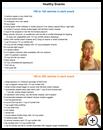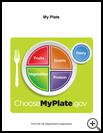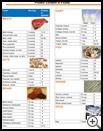
Healthy Diet
________________________________________________________________________
KEY POINTS
- To have a healthy diet, you need to make smart choices from every food group, balance how much you eat with how much physical activity you do, and make sure that you get the most nutrition from the calories you eat.
- Limit saturated fats, trans fats, cholesterol, sodium, and added sugars in your diet. You can use information on the Nutrition Facts label to help you make healthy food choices.
________________________________________________________________________
What are the keys to a healthy diet?
Your daily diet and physical activity are important to your health. They are important for how you feel today and how you will feel in the future. The 3 keys to a healthy diet are:
- Make smart choices from every food group: fruits, vegetables, grains, milk products, meat (or other protein-rich foods), and fats.
- Find a balance between how much food you eat and how much physical activity you do.
- Get the most nutrition out of your calories.
What is ChooseMyPlate?
ChooseMyPlate is a way to help you make healthy food choices in the right portions. You divide a 9-inch plate into portions for fruits and vegetables, grains and starches, and proteins. This helps you to choose foods for breakfast, lunch, and dinner. Fill half of the plate with fruits and vegetables. The other half of the plate should be split evenly. In one section, put starches, such as whole grains and starchy vegetables like potatoes. The last section is for proteins such as lean meat, beans, and peas. You can also have cup of dairy, such as low-fat or skim milk or yogurt on the side.
What are healthy food choices?
A healthy diet:
- Includes a lot of fruits, vegetables, whole grains, beans, and fat-free or low-fat milk and milk products.
- Includes soy protein, eggs, nuts, poultry, fish, and lean meats (if you choose to include meat in your diet).
- Is low in saturated fats, trans fats, cholesterol, salt (sodium), and added sugars.
Fruits and vegetables
Eat a variety of fresh, frozen, canned, or dried fruits rather than fruit juice for most of your fruit choices. Fruit juice is higher in calories and sugar and has little to no fiber.
Choose from a variety of vegetables. Some of the healthiest vegetables are:
- Green vegetables, such as broccoli, cabbage, and dark leafy greens
- Yellow, orange, and red vegetables, such as peppers, tomatoes, carrots, sweet potatoes, pumpkin, and squash.
Whole grains
Whole grains are a healthier choice than refined grains. Whole grains are high in fiber and rich in protein, vitamins, minerals, and essential fatty acids. Make sure that at least half of the grains you eat are whole grains. Whole-grain cereals, breads, crackers, rice, or pasta are good choices. Look for products that list whole grains or whole wheat as one of the first ingredients.
Foods with fiber
Fiber helps to prevent constipation. It also helps keep your blood glucose steady and helps lower cholesterol levels. In general, it is recommended that adult women get 25 grams of fiber and adult men get 38 grams of fiber each day. Whole-grain sources of fiber include whole wheat, bran, whole rye, oats and oatmeal, whole-grain corn, and brown or wild rice. Other good sources of fiber are flax seeds, nuts, vegetables, fruits, and beans.
Dairy products
Get 3 cups of low-fat or fat-free milk - or an equivalent amount of low-fat yogurt or low-fat cheese (1 and 1/2 ounces of cheese equals 1 cup of milk) - every day. If you don't or can’t drink cow's milk, choose lactose-free milk products or calcium-fortified soy, almond, or rice milk.
Protein-rich foods
Choose lean meats, poultry, and fish for your protein portions. Bake, broil, or grill these foods instead of frying them. Eat 8 to 12 ounces of fish a week and get some of your protein from other foods, such as beans, peas, nuts, and seeds. Try to use meat as a side dish rather than a main course. Instead of the main part of your meal, think of meat as a flavoring, such as in a casserole or stew.
You can have a healthy diet without eating meat. Vegetarians need to make sure to eat a variety of nonmeat proteins every day and to get enough iron and zinc. Beans such as kidney, garbanzo, navy, and pinto beans; lentils; and split peas, are good sources of protein and iron. They add variety, flavor, and fiber to your diet.
Healthy Fats
Very low fat diets are not recommended. Fats should make up 20 to 35% of daily calories. Most of the fats in your diet should be healthy, polyunsaturated and monounsaturated fats, such as canola, olive, peanut, and flaxseed oil. When you buy foods such as margarine, mayonnaise, and salad dressings, look for products made with these healthy oils and no trans fats. Three to 6 daily servings of added fat are recommended. One serving equals 1 teaspoon of oil or 1 tablespoon of a reduced-fat product. You don't have to use added fats to include healthy fat in your diet. Eating avocado and small portions of nuts (1/4 cup) and seeds (2 tablespoons) and having fatty fish a few times a week is a good way to get healthy fats without adding too many extra calories.
What foods should I limit?
Some foods contain very little nutritional value. Some have ingredients that can contribute to problems such as diabetes or high blood pressure if eaten in large amounts, or over a long time. Eating healthy doesn't mean giving up all sweets, salt, and snacks. It means eating them in small portions and less often. You should limit saturated fats, trans fats, cholesterol, sodium, and added sugars in your diet. Reading the Nutrition Facts label on foods can help you do this.
Unhealthy fats
Avoiding foods high in saturated fats, trans fats, and cholesterol may help reduce your risk of heart disease. Examples of foods that contain saturated fat include butter, cheese, and other whole-milk products; the fats in meat and poultry skin; and tropical oils such as coconut and palm oil. Saturated fats should make up no more than 10% of your daily calories. Limiting saturated fat to 5 or 6% of your total calories may further reduce your risk for heart disease. Some margarines, shortening, and many packaged convenience, snack, and fast foods contain trans fats. Trans fats are made with a process called hydrogenation. It is done to keep fat from going bad and turns the fat from a liquid to a solid. Try to eat as little trans fat as possible. Cholesterol is a substance found in animal products such as meat, eggs, dairy products, and baked goods made with eggs and milk. You should have no more than 300 milligrams (mg) of cholesterol a day.
Salt
Choose and prepare foods and beverages with little salt (sodium). Most sodium in the diet comes from processed and fast foods. Try to limit your salt intake to no more than 2300 mg (equal to 1 teaspoon of salt) a day. If you are 51 or older, you are African American, or you have hypertension, diabetes, or chronic kidney disease, a lower salt intake may be recommended by your healthcare provider. Eating less than 1,500 milligrams of sodium a day may lower the risk of high blood pressure. Taste food before you add salt to it. Try adding other spices or herbs, instead of salt, to the foods you cook and eat.
Sugars
Eating too much added sugar is linked to gaining too much weight and other health risks, such as a tooth decay or diabetes. Choose foods and drinks low in added sugars. Foods that are high in sugar have a lot of calories with few, if any, other nutrients. Read the ingredient list for packaged foods and make sure that added sugars are not one of the first few ingredients. Some names for added sugars are high fructose corn syrup, sucrose, glucose, corn syrup, corn sweetener, maple syrup, and fructose.
The American Heart Association advises that women should get no more than 100 of their daily calories (25 grams of carbohydrate) from added sugar and men get no more than 150 calories (37.5 grams of carbohydrate) from added sugar. One 12-ounce can of regular soda contains about 155 calories from added sugar.
Alcohol
Alcohol has calories but little nutritional value. If you choose to drink alcohol, limit it to 1 drink a day for women and 2 drinks a day for men. A drink equals 12 ounces of regular beer, 5 ounces of wine, or 1 and 1/2 ounces of 80-proof distilled spirits. Drinking more alcohol than this can lead to health problems and make some medical problems worse.
What are calories?
Calories are a way to measure the energy value of food. Your body needs the right amount of calories for you to have the energy to do things. How many calories you should eat depends on your age, activity level, and whether you are trying to gain, maintain, or lose weight.
If you want to stay at your current weight, eat the same number of calories as you burn every day. If you want to lose weight, you need to eat fewer calories and increase your physical activity. If you eat 100 more calories a day than you burn, you will gain about 10 pounds a year.
How does the Nutrition Facts Label help?
Most packaged foods have a Nutrition Facts label. Use information on this label to help you make healthy food choices.
For example, the % Daily Value (DV) section can help you know how much fat, protein, sugar, and salt (sodium) you will get in a serving of the food. If a serving of a food has 5% DV or less of a nutrient, it is considered low in that nutrient. 20% DV or more is considered high. Try these tips:
- Keep these low: saturated fats, trans fats, cholesterol, and sodium.
- Get enough of these: potassium, fiber, vitamins A and C, calcium, and iron.
Look at the serving size listed on the label and think about how many servings are actually in the package. For example, if a can of soup has 2 servings and you eat the whole can, you eat 2 times the calories and nutrients listed for 1 serving. Look at the calories on the label and compare them with the nutrients to decide whether the food is a healthy choice. If a single serving of a food has over 400 calories, it is high in calories.
How do I know if I am eating a healthy diet?
If you feel good, your skin is clear, and you have plenty of energy, you are probably eating a healthy diet. If you are not getting enough vitamins or minerals, you may have symptoms such as:
- Rashes
- A painful, swollen tongue
- Tiredness
- Irritability
- Depression
- Pale skin
- Trouble focusing
Check with your healthcare provider if you think you may not be getting all the nutrients you need.
Why is physical activity also important?
Regular physical activity helps you control body weight by balancing the calories you take in from food with the calories you burn each day. It is important for your overall health and fitness.
- Be physically active. A healthy goal for most adults is to exercise for 2 hours and 30 minutes or more each week. You don't need to do 30 minutes of activity all at once. You can do shorter periods, at least 10 minutes each time. Increasing the intensity of your exercise or getting at least 5 hours (300 minutes) of moderate exercise a week can help you lose weight.
- Follow your healthcare provider's exercise recommendations for an exercise program that is right for you.
Where can I get more information?
You can get more information from:
- USDA ChooseMyPlate
https://www.choosemyplate.gov/ - USDA Dietary Guidelines for Americans
https://www.cnpp.usda.gov/dietary-guidelines



